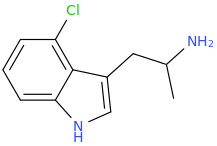So I've been lurking Bluelight for quite some time before finally making an account and in all my time I have never once even seen a discussion about either of these two compounds in any length - which to me is quite surprising even a cursory Wikipedia article reading of 5-Chloro-aMT in particular gives you a very promising impression that this compound is quite special and it seems like this forum is always brimming with excitement for new RC psychedelics. First and foremost, these two compounds are, so far, the only two known selective serotonin-dopamine releasing agents in the entire history of pharmacology - 5-Chloro-aMT in particular is a highly selective and well balanced SDRA with EC50 values for serotonin, dopamine, and norepinephrine release being 16 nM, 54 nM, and 3434 nM respectively (correspondingly giving it roughly 64-fold selectivity for dopamine over norepinephrine and 3-fold selectivity for serotonin over dopamine). You might be wondering what value a selective SDRA would even have over a SNDRA psychedlic like the parent compounds aMT and aET. Well this is largely speculation on my part but I do believe it is logically founded; norepinephrine release (as well as adrenergic receptor agonism) is what is usually implicated in host of nasty side effects while not really over much, if any, recreational value. This includes psychological effects such as anxiety, agitation, and even aggressiveness as well as several sypathomimetic and cardiovascular complications such as tachycardia, insomnia, restlessness, and shortness of breath. Especially for drugs as sensitisizing as psychedelics anxiety can properly ruin an experience. One of the most common complaints I read about aMT and aET (which do have a norepinephrine releasing component) is that it has a "dirty" feeling for some as a result of over-stimulation. In contrast, I could compare it to another halogenated drug of the stimulant class - 4-FA - which is said to feel quite "clean" in large part due to its limited A1 receptor agonism and norepinephrine reuptake inhibition. On top of that, both 5-Chloro-aMT and 5-Fluoro-aET are both full agonists to 5HT-2A receptor subfamily (5-Chloro-aMT has an EC50 value of 6.27 nM and an efficacy of 105%) which means they are very likely to be potent, full-bodied (if you will) psychedelics. To this effect, 5-Fluoro-aET has shown to produce a strong head-twitch response in rats during lab studies which is highly correlated with psychedelic response in humans; it is highly probable 5-Chloro-aMT also possess this quality. This addresses the other most common complaint people have with aMT and aET: that they are somewhat lacklustre psychedelics in their own right - lacking profound changes in thought or perception. The lack of profundity of those two compounds likely is the result of their somewhat less potent binding affinity and only partially agonistic efficacy at the 5HT-2A receptor. Unfortunately, 5-Chloro-aMT and 5-Fluoro-aET with still likely have one of the other problems that their parents compounds have and that's very possible effect as a RIMA (or MAO-A inhibitor) which while they relatively weak in this regard could potentially cause dangerous interactions if taken with other potent serotonin releasing agents such as MDMA. On top of that, just like practically all potent serotonin and dopamine releasing agents the potential for neurotoxicity is very real although there is reason to believe it still won't be as severe as MDMA (which itself is not an enormous concern). As with the parent compounds it will be prudent to cautiously dose and avoid hazardous drug combinations. In summary, I for one am very excited to see these two compounds enter the grey and black markets and hope I may test them myself even if only to experience their uniqueness; however, it is worth noting that with all of the engineered RC tryptamines they will probably be a bit costly to produce but that didn't stop the other from becoming fairly popular. To finish I'll leave you with a quote from a study done on these two compounds: "The unique combination of dual DA/5-HT releasing activity and 5-HT2A receptor activity suggests that these compounds could represent a new class of neurotransmitter releasers with therapeutic potential."
Citations:
https://en.wikipedia.org/wiki/Serotonin-dopamine_releasing_agent
https://en.wikipedia.org/wiki/5-Chloro-αMT
http://www.sciencedirect.com/science/article/pii/S0960894X14007860
http://psycnet.apa.org/journals/pha/22/3/274/
Citations:
https://en.wikipedia.org/wiki/Serotonin-dopamine_releasing_agent
https://en.wikipedia.org/wiki/5-Chloro-αMT
http://www.sciencedirect.com/science/article/pii/S0960894X14007860
http://psycnet.apa.org/journals/pha/22/3/274/

